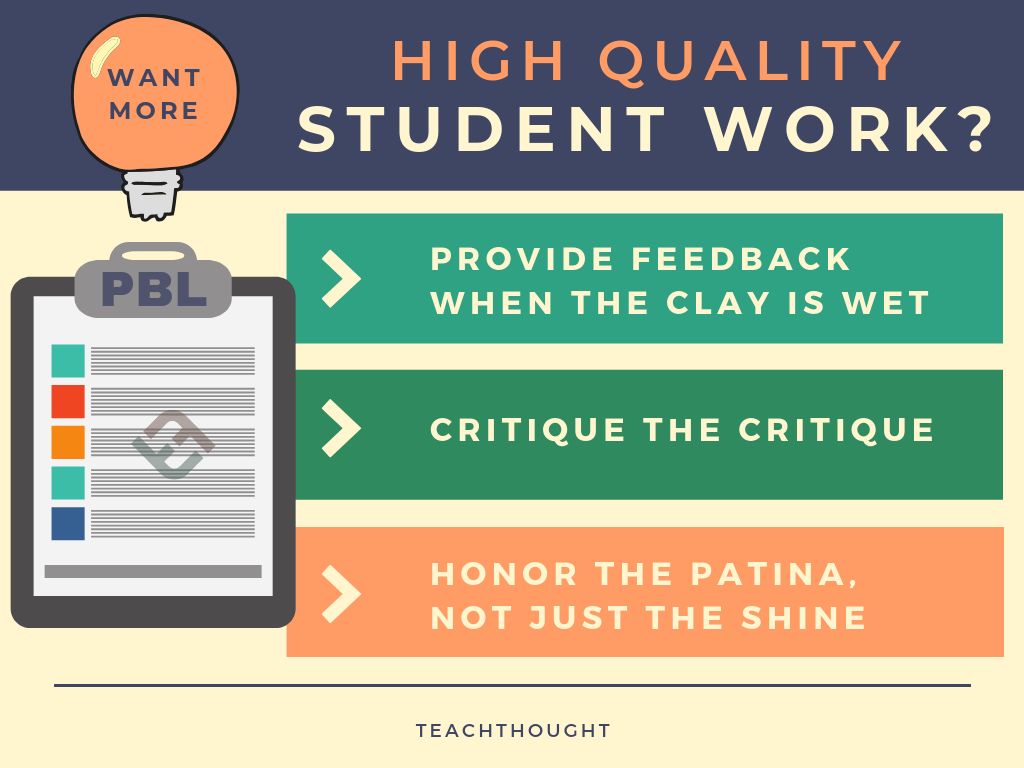
Lessons Learned On The Journey To High Quality Student Work (Part 1)
contributed by Eric White
*this blog is part 1 of 2 (read part 2 here)
While educators have differing philosophies on how students best learn, one statement I routinely make continues to gain unanimous agreement with teachers: “Students can produce higher quality work than they are currently producing.” It is not an issue of philosophy, but one of practicality. How can we make high-quality student work a feasible reality in our classrooms? Below are some lessons learned that have helped me on my journey.
Lesson #1: Provide Feedback When the Clay is Wet
When providing feedback on student work, one rule rings true: do it early and often. This approach not only results in better work, but it also fosters student motivation and a growth mindset. Nothing can kill a student’s drive more than being asked to revise work, especially if it involves drastic changes, after they’ve already committed an extensive amount of time. I learned this lesson the hard way.
A few years ago, I assigned students the task of writing an editorial to promote an opinion or a solution to a current issue. I informed them that they would have two class periods to develop their draft and one period to complete revisions. Students were generally motivated to do well on the assignment, but I killed that when I offered my feedback on the third and final day of the assignment. I recall one particular student who refused to make his revisions. More than a little irritated, I asked him what his problem was. Looking down at the red ink that covered his writing he said, “I’ve gone too far to start over. Just give me an F.”
The bottom line is that early and often drafts must be a part of the learning process. When feedback is provided when the clay is still wet, the work can take shape much easier than breaking the pot and starting over.
Lesson #2: Critique the Critique
I love using peer critique for a variety of reasons. It can build a culture of high-quality work in the classroom, and it truly warms my heart to see students mutually invest in each other. In a classroom that embraces peer critique, students are obligated and empowered to help everyone succeed. But, with that empowerment comes accountability. If valuable class time is being used for peer critique, the quality of that feedback must also be up for review.
I must admit, my first few attempts at peer critique were a complete waste of time. I tried using a variety of critique strategies, thinking that those opportunities for peer feedback would improve the work and make my job more efficient when my turn came. Wrong! Most of the feedback was general and did little to push the work forward. After a few disappointing rounds only seeing phrases like “good job” and “looks good to me,” I decided to jump off the treadmill of half-hearted critique and offer support.
This support started with students reviewing and evaluating low, medium, and high-quality models of student feedback. Then, I assigned each class to create a “Critique Do’s & Don’ts” anchor chart to offer visual reminders during peer critique. One group of students took the assignment a bit further and offered an additional “Mad Libs” section, which involved some fill-in-the-blank sentences starters (ex. “What if you tried __________ to improve __________ about __________?”). This investment in time to recalibrate their understanding around peer critique paid off as students became much more specific and intentional about what they were saying and writing to each other.
Oh, and one more thing…
Armed with this new understanding, be ready for students to call you out on your critique pitfalls. Mine wasted no time with reminding me of all the times I simply wrote, “excellent” on their papers, and they had the evidence to prove it. Accountability works both ways.
Lesson #3: Honor the Patina, Not Just the Shine
In my zeal to lead students to high-quality work, I became obsessed with how the final products looked, especially with student projects. I wanted to turn my hallway into a museum that highlighted only the best. Aesthetics and craftsmanship matter, but my tunnel vision turned many of my students off. I had become too focused on “pretty” products, and that prevented me from respecting the real learning.
To honor all student growth, I turned my focus from product to process. Students started archiving drafts of work in their digital portfolios. In the past, students had just thrown those away. Now, they were platforms for reflection and growth. It was amazing to look back on a project and see how a student progressed through those drafts. It provided a compelling narrative of the struggles and accomplishments that can only happen when you are willing to curate and use crude, flawed work.
Remember, shiny end products can be nice. However, nothing is more beautiful than the patina that is earned over time through imperfect drafts. Perhaps nothing makes this point clearly than Austin’s Butterfly.
Read Part 2 for my three final lessons and a bonus tip that might be the most important of all.
image attribution: Eric White’s classroom
